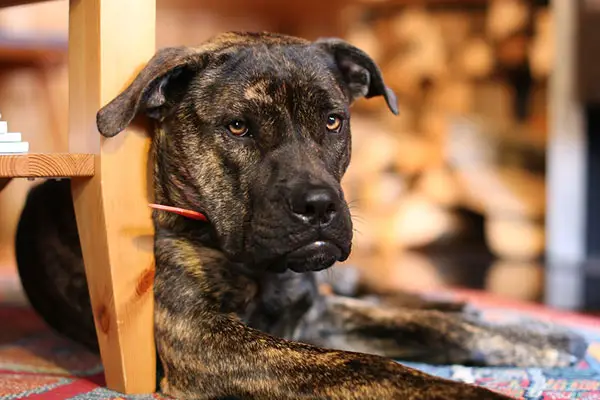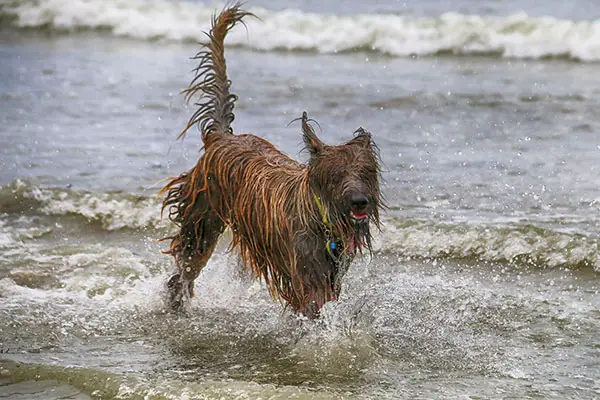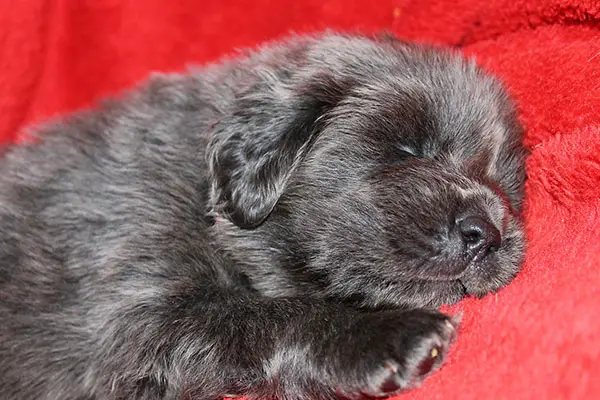Though large and majestic in appearance, Tibetan Mastiffs are gentle dogs known for their heavy coats and bushy tails that curve over their backs. The Tibetan Mastiff usually stands at a height of 26 inches and weighs over 100 pounds, which will likely intimidate any intruder that comes to your home.
For owners, however, these are loving, patient, and understanding dogs. They’re also hard workers and undeniably fearless. Their stubborn attitude will make it hard for inexperienced owners to handle them. Instead, they require someone firm and consistent, who can give them the right obedience training.
Tibetan Mastiffs find it hard to adapt to any kind of lifestyle. But if you happen to be an excellent fit for these dogs, you surely got yourself an exciting companion.

Tibetan Mastiff Breed Statistics
| Dog Breed Group | Working Group |
| Breed Size | Large to Giant |
| Height | minimum 26 inches (male); minimum 24 inches (female) |
| Weight | 90-150 pounds (male); 70-120 pounds (female) |
| Lifespan | 12-14 years |
Tibetan Mastiff Breed Ratings
| Energy level | |
| Exercise needs | |
| Requires attention | |
| Playfulness | |
| Trainability | |
| Shedding | |
| Grooming | |
| Friendly with family | |
| Friendly with kids | |
| Friendly with strangers | |
| Friendly with other dogs | |
| Prey Drive |
Tibetan Mastiff History
Tibetan Mastiffs are one of the oldest breeds in the world. They are even considered to be one of the descendants of Mastiff-type dogs that existed about five centuries ago.
Tibetan Mastiffs are said to have originated in Tibet. However, like many ancient dog breeds, there were so little records of them in history. According to historians, Tibetan Mastiffs were developed into two types:
Do-Khyi – Tibetan Mastiffs lived in the villages or traveled with nomadic shepherds; they were also guardians of the flock.
Tsang-Khyi – Tibetan Mastiffs that were given to lamaseries and served as guardians for Tibetan Buddhist monks.
For most of their history, Tibetan Mastiffs remained unknown to the world until 1847. The Viceroy of India, Lord Hardinge, sent the first Tibetan Mastiff to Queen Victoria as a gift. So by 1873, when England’s Kennel Club was founded, the Tibetan Mastiff was officially added to the studbook.
By 1874, the dog’s popularity increased when the Prince of Wales imported two more of the dog breed to England and showed them in 1875 at the Alexandra Palace Show.
The Tibetan Mastiffs’ importation to England continued, and by 1931, the first Tibetan Mastiff Club was formed.
The dogs were first introduced in the US in the late 1950s, but they were taken to a farm and vanished from the public’s eyes. Importation started again in 1970, and the Tibetan Mastiff Club of America was formed in 1974.
Though they’ve been in the US for long, the breed is still considered rare. Even in Tibet, it’s hard to find a purebred Tibetan Mastiff. They were only recognized by the American Kennel Club in 2006 and were classified under the working group in 2007.
Now, the breed ranks 131st as the most popular dog breed in the US.
Tibetan Mastiff Temperament
Tibetan Mastiffs are independent, reserved, and intelligent dogs. This is a powerful and rugged dog breed but is not inclined to play fetch or frisbees in the yard. These dogs are developed for working, so work is more ingrained than play.
These dogs are dedicated guardians, may it be for your flocks or territory. They are great dogs for those who own farms and need someone to patrol the territory. You also need to make sure that you have secured and tall fences so they can’t easily escape.
Other than being working dogs, Tibetan Mastiffs also make great family companions. They love to please their families, and their loyalty is very impressive. They are also known to be gentle and patient with children but always keep close supervision. They are also good with dogs, as well as with other pets.
Tibetan Mastiffs are aloof with strangers and keep an alert eye the whole time they are on your property. They will usually remain calm and quiet unless provoked.
They can be very protective, and they tend to make decisions on their own. Early socialization is crucial to maintain a stable temperament. These dogs usually decide who is a friend or an enemy, or whether someone is a threat, making it hard for people to come by your home.
Training will be a big challenge for these strong-willed and self-reliant dogs. They are best paired with experienced and assertive owners who will demand respect. They are not dogs for an average household, and it’s not that easy to keep them happy.

Tibetan Mastiff Care Requirements
- Nutrition: Tibetan Mastiffs only require a high-quality and well-balanced meal to remain healthy. They will do well in any type of diet your vet may suggest. The only thing you need to be careful of is the number of calories you feed in a day. Besides your dog’s size, you also need to consider his age and activity level to know how much food he needs in a day. Overfeeding your dog will cause him to become overweight, making him more susceptible to diseases. If you’re going to give him a home-cooked diet or a raw diet, make sure that you only buy high-quality ingredients. Meals should also be packed with proteins, fats, and carbohydrates. Fruits and vegetables are also great to add for better digestion. For dog food, choose only the premium quality ones. Check the label and stay away from dog food containing fillers, additives, by-products, and any other ingredients your Tibetan Mastiff is allergic to.
- Grooming: Tibetan Mastiffs have double-coated coats that shed seasonally. It requires very minimal grooming through weekly brushing, though you might have to do this daily during the shedding season. Brushing will help remove any debris, excess hair, and tangles to keep your dog looking neat. Trimming can be given but only to shape their feet. You shouldn’t clip or trim the hairs on their bodies or heads, which may affect their appearance. Baths can be given occasionally, depending on how messy they become. Ears should be cleaned regularly to prevent ear infection. Nails should also be checked and trimmed every two weeks so as not to give your dog pain and discomfort.
- Exercise: Tibetan Mastiffs are giant-sized dogs that need moderate and regular exercise. However, these activities don’t have to be high-impacting or organized. Tibetan Mastiffs are happiest when they’re given work. This can be through guarding the flock or patrolling the area. Play sessions would not be an excellent option for them, but you can always take them out for long daily walks.
- Health: Tibetan Mastiffs are healthy dogs with a fairly long lifespan. However, like all breeds, they are susceptible to several health conditions. Although your dog may not get all of these diseases, it’s still best to be aware of them. These large dogs are prone to bone diseases like canine hip dysplasia, elbow dysplasia, panosteitis, and osteochondrosis dissecans. This is why it’s essential to give them regular exercise to keep them healthy. Your dog may also suffer from hereditary diseases such as canine inherited demyelinative neuropathy and autoimmune hypothyroidism. We highly recommend meeting at least one of the parents to be aware of any genetic disease your dog may acquire. Closely monitoring your dog’s behavior will also help. Plus, there are screening tests your dog can take to detect certain diseases at an early stage.
- Lifespan: The life expectancy of Tibetan Mastiffs is 10-12 years.
Famous Tibetan Mastiffs
- Sireng: The first Tibetan Mastiff gifted by the Viceroy of India to Queen Victoria
- Yushu: The heaviest Tibetan Mastiff; weighed up to 250 pounds
Fun Facts about Tibetan Mastiffs
- Tibetan Mastiffs originated from Tibet.
- These dogs are one of the largest dog breeds around the world.
- They were mainly developed to work; these dogs are usually used to guard flocks or lamaseries.
- They are called Do-Khyi in Tibet; this means “Tied Dog” because they are traditionally kept chained to gates and let loose at night.
- They arrived in Europe in the 19th century.
- They prefer to be in a cold climate; if you live in a hot or humid environment, they need to be in air-conditioned facilities.
- They are climbers or jumpers; fences should be tall and secured.
- These dogs are the most expensive dog in the world.
- They were recognized by the American Kennel Club in 2006.

